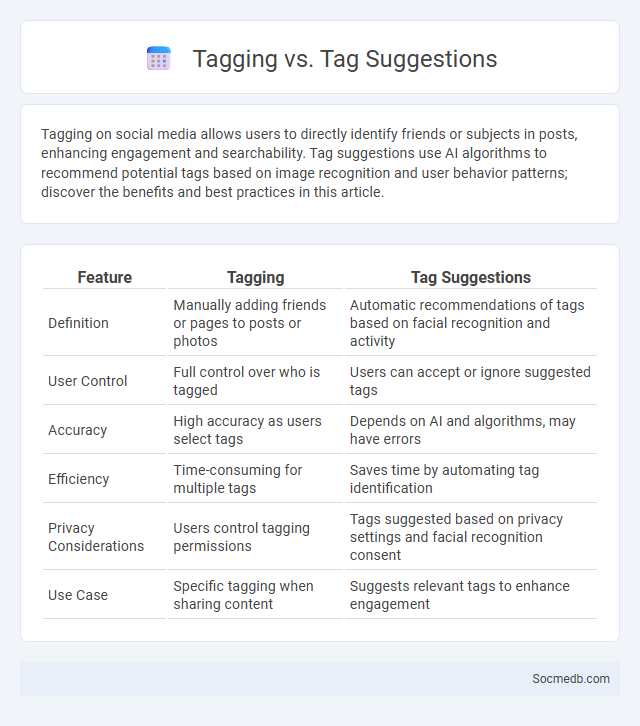
Photo illustration: Tagging vs Tag Suggestions
Tagging on social media allows users to directly identify friends or subjects in posts, enhancing engagement and searchability. Tag suggestions use AI algorithms to recommend potential tags based on image recognition and user behavior patterns; discover the benefits and best practices in this article.
Table of Comparison
| Feature | Tagging | Tag Suggestions |
|---|---|---|
| Definition | Manually adding friends or pages to posts or photos | Automatic recommendations of tags based on facial recognition and activity |
| User Control | Full control over who is tagged | Users can accept or ignore suggested tags |
| Accuracy | High accuracy as users select tags | Depends on AI and algorithms, may have errors |
| Efficiency | Time-consuming for multiple tags | Saves time by automating tag identification |
| Privacy Considerations | Users control tagging permissions | Tags suggested based on privacy settings and facial recognition consent |
| Use Case | Specific tagging when sharing content | Suggests relevant tags to enhance engagement |
Understanding Tagging: Definition and Purpose
Tagging in social media involves identifying users, locations, or topics within a post to enhance discoverability and engagement. This feature allows users to link content directly to relevant profiles or subjects, increasing interaction and visibility across platforms like Instagram, Facebook, and Twitter. Proper tagging helps categorize content, facilitates network building, and drives targeted traffic by connecting posts to interested communities and trending conversations.
What Are Tag Suggestions?
Tag suggestions are automated recommendations generated by social media platforms to help you categorize and enhance the discoverability of your content. These suggestions are based on trends, user behavior, and the context of your post, making it easier to reach a wider audience. Utilizing tag suggestions strategically can boost engagement and improve your content's visibility across social networks.
Differences Between Manual Tagging and Tag Suggestions
Manual tagging requires users to individually assign relevant keywords or labels to content, ensuring precise categorization and personalized context. Tag suggestions use algorithms and machine learning models to automatically recommend relevant tags based on content analysis, increasing efficiency and consistency. While manual tagging offers better accuracy, tag suggestions significantly reduce time and effort in managing large volumes of social media posts.
Benefits of Manual Tagging in Content Organization
Manual tagging in social media content organization enhances searchability by applying precise, context-relevant keywords that algorithms might overlook, improving user experience and engagement. It allows for nuanced categorization, enabling targeted audience segmentation and more effective content discovery. This method supports better analytics and insights by creating structured data that reflects true content themes and user interests.
How Tag Suggestions Enhance User Experience
Tag suggestions streamline your social media interactions by providing relevant and popular hashtags that increase content visibility. This feature helps you connect with targeted communities, boosting engagement and reach organically. By simplifying the tagging process, tag suggestions enhance the overall efficiency and enjoyment of sharing posts.
Tagging vs Tag Suggestions: Key Use Cases
Tagging enables users to manually identify people, places, or topics in social media posts, enhancing content discoverability and personal engagement. Tag suggestions use AI algorithms to automatically recommend relevant tags based on image recognition and text analysis, streamlining the tagging process and increasing accuracy. Effective use of tagging and tag suggestions improves user interaction, content categorization, and targeted marketing campaigns on platforms like Instagram, Facebook, and Twitter.
Common Challenges in Tagging and Tag Suggestions
Common challenges in social media tagging include inaccurate tag suggestions leading to irrelevant content association and user frustration. Automated tag recommendations often struggle with context understanding, resulting in generic or misleading tags that diminish engagement quality. Ensuring precise semantic recognition and personalized tag algorithms can significantly improve relevance and user experience.
Best Practices for Implementing Tagging Systems
Implementing effective tagging systems on social media enhances content discoverability and user engagement by organizing posts with relevant keywords and categories. Utilizing consistent, descriptive, and widely recognized tags improves search accuracy and helps algorithms recommend content more efficiently. Regularly reviewing and refining tags based on performance analytics ensures the tagging strategy remains aligned with user interests and platform trends.
Leveraging AI for Advanced Tag Suggestions
Leveraging AI for advanced tag suggestions on social media enhances content discoverability by analyzing user behavior, trending topics, and contextual relevance in real time. Machine learning algorithms generate highly accurate and personalized tags, increasing engagement and reach across platforms such as Instagram, Twitter, and TikTok. Implementing AI-driven tag tools improves SEO performance and drives targeted traffic by aligning posts with evolving audience interests and search patterns.
Future Trends in Tagging and Tag Suggestion Technologies
Future trends in social media tagging emphasize AI-powered tag suggestion technologies that leverage machine learning algorithms to analyze user content contextually, enhancing accuracy and relevance. Advanced natural language processing and image recognition enable real-time, automated tagging that improves content discoverability and user engagement across platforms like Instagram, Facebook, and TikTok. Privacy-preserving techniques and personalized tag recommendations tailored to individual user behavior are set to redefine social media interactions by offering more intuitive and secure tagging experiences.
 socmedb.com
socmedb.com